Landing page SEO best practices: A step-by-step guide
By Phil Norris December 5, 2023
Landing pages are fantastic at driving leads and sales, but they’re often not so good at bringing in organic traffic.
Why? Because the very factors that help landing pages convert visitors — minimal content, few links, and highly promotional messaging — are pretty much the opposite of what search engines like Google are looking for.
But, if you follow some tried-and-trusted methodologies, it’s totally possible to build landing pages that rank well, bring in tons of traffic, and achieve sky-high conversion rates.
Learn how in our guide to landing page SEO…
What is an SEO landing page?
SEO landing pages are web pages optimized to:
- Rank well in search
- Drive lots of leads or sales
Landing pages serve a single purpose or goal. Most often, the goal will be to sell a product or service, capture an email address or drive signups to an event or webinar.
Often, a landing page is one of many pages on a website.
But there are also plenty of standalone landing pages out there, built using landing page tools like AWeber and Unbounce.
They generate relevant traffic by targeting specific keywords. And they feature some sort of call to action (CTA), typically a lead capture form or a “buy now” button.
Just like this one:
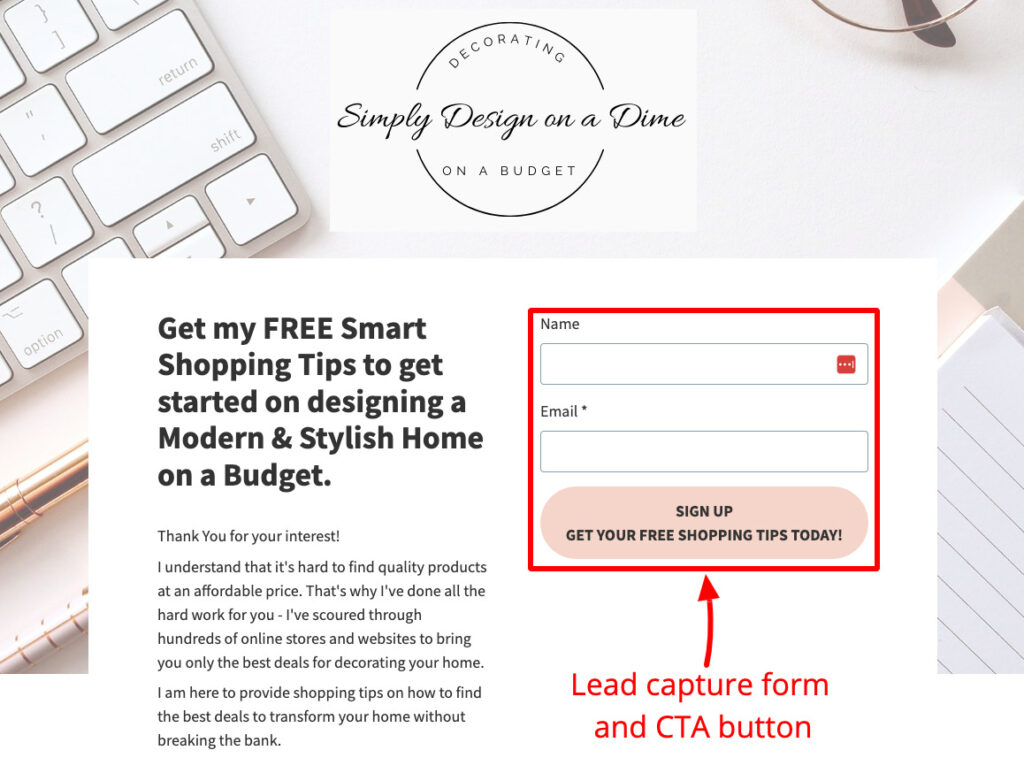
Why isn’t your SEO landing page ranking?
It’s a tough task getting any SEO landing page to perform well in search.
Fact is, Google (probably) uses 200+ different factors to determine rankings, including:
- Content quality
- Backlinks
- Keyword optimization
- Site speed
- Mobile friendliness
It’s hard to satisfy many of those factors if you don’t have much content on your landing page. And it gets even harder if you’re building a standalone landing page.
For starters, you don’t have the authority of an existing website to prop up your rankings.
What’s more, you can’t take advantage of internal linking — a simple-but-effective SEO tactic that boosts a landing page’s authority by linking to it from lots of other pages on the same site. This clearly isn’t an option if you’re creating a standalone page because you don’t have any other pages.
Landing page SEO best practices: A step-by-step optimization guide
Sure, landing page SEO is challenging.
But it’s not all bad news, because there are plenty of examples of standalone landing pages that punch way above their weight in the search rankings.
For instance, at time of writing, this landing page about author and business expert Jay Baer’s favorite tequila brands…
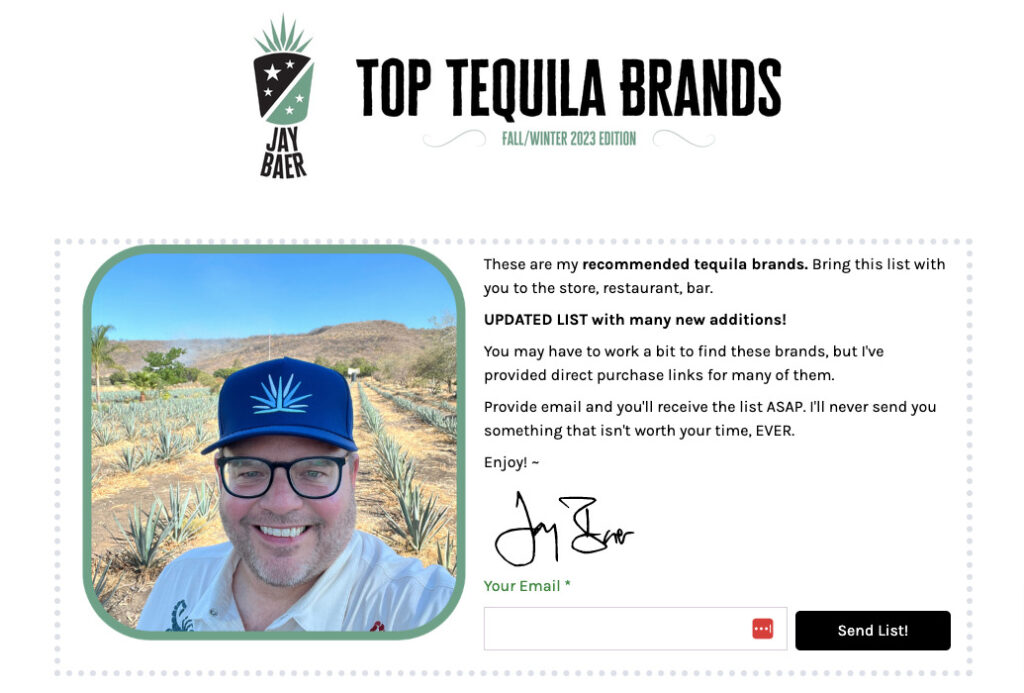
…was ranking at #6 for the term “tequila lists”, which gets a respectable 300 estimated searches a month.
That’s despite having fewer than 70 words on the whole page. With a little more content and some smart SEO, we bet it could rank even higher.
Want to do the same? Use our landing page SEO tips and tricks to boost your search rankings and generate more traffic, leads, and sales.
(FYI these tactics will work just as well for “regular” landing pages that are part of a full website. If anything, they’ll be even more effective, because it’s generally easier to rank with a website page than a standalone landing page.)
Identify low-difficulty target keywords
The ultimate goal of landing page SEO is to rank for relevant keywords with decent search volume.
You need to be realistic here.
Imagine you and I wanted to build a standalone SEO landing page for our new yoga business.
We might want to target a broad term like “yoga mat”, which gets an estimated 215,000 global searches a month.
But the top 10 search results are full of massive brands, retailers, and publishers like Amazon, Target, and the New York Times. There’s zero chance we’ll outrank any of them with a solitary landing page. We’d be a small fish in a huge pond.
Instead, our job is to find a more specific keyword. Fewer people will be searching for it, so it’ll be far less competitive. We’re still a small fish — but the pond just got a lot smaller, too.
Realistically, to find those low-difficulty keyword opportunities, you need to sign up for an SEO research tool like:
The first two are superb, but they’re also pretty expensive at $100+ per month.
Ubersuggest doesn’t have as many features, but it’s a whole lot cheaper (starting at $29/month), and it even gives you a limited amount of free functionality. So we’re going to show you how to use it to track down that low-hanging keyword fruit.
First, you need to enter a “seed” keyword — a broad term like “yoga mat” that we’ll use to find more specific variants.

Now for the good stuff: choose Related terms to broaden out our search, then use the SEO Difficulty filter to exclude any keywords with a score over 30, because those terms may just be too competitive.
(Bear in mind that different tools have different ways of ranking keyword difficulty. For instance, Ahrefs tends to give lower difficulty scores than Ubersuggest. So if you’re using Ahrefs, set a lower maximum keyword difficulty; 15 – 20 should be fine).
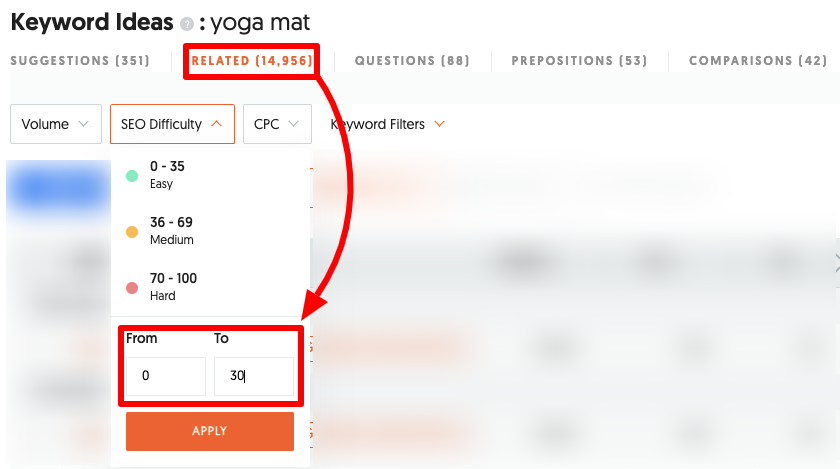
Hopefully, that’ll spit out a bunch of relevant results.
Now, hit the Volume filter so you’ve got a list of the lowest-competition keywords with the highest number of estimated monthly searches:
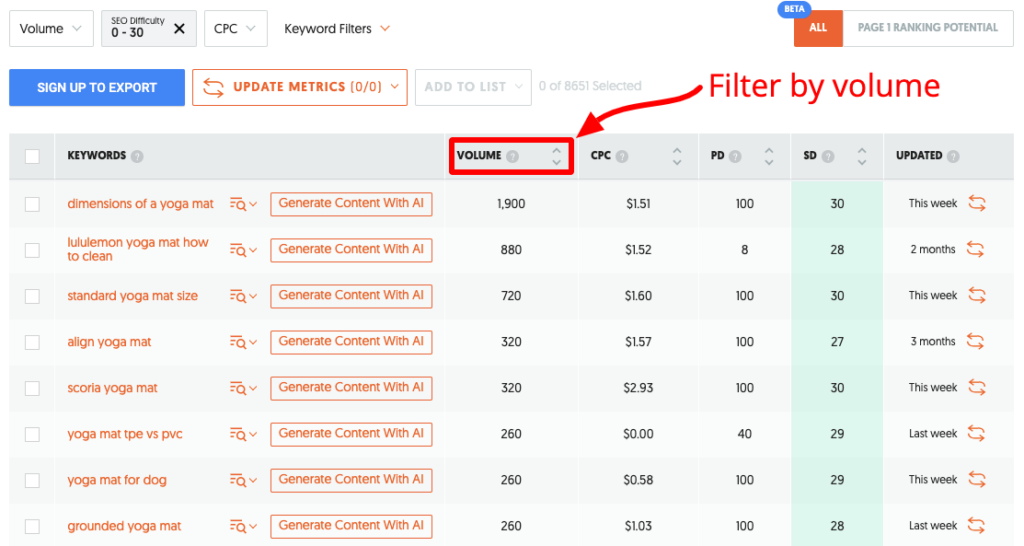
Then it’s just a case of reviewing the results and picking out any that catch the eye.
At first glance, “dimensions of a yoga mat” looks interesting. Sure, it doesn’t show much buying intent, but it has a ton of volume (1,900 searches a month). We could bring those searchers to our landing page, explain all the different yoga mat dimensions, then recommend a bunch of mats in each size category.
Or there’s always “yoga mat for dog” (260 searches a month) if we fancy really niche-ing down.
You may need to do some additional research at this stage to figure out the intent behind a keyword and whether it’s worth pursuing.
For instance, people Googling “grounded yoga mat” (260 monthly searches) are looking for a mat that supposedly creates an electrical connection between the earth and the yogi using it. If that’s something we sell in our imaginary yoga store, it’s a decent term to target.
Choose the best of the bunch and make a note of it; that’s your primary keyword.
Or if none of them works for you, start over with a different seed keyword.
👉 Do this: Once you’ve found your primary keyword, Google it, then pick out potential secondary keywords in the “People also ask” and “Related searches” sections. For instance, “what is a standard yoga mat size” could make a useful subheading on a landing page targeting the primary term “dimensions of a yoga mat”:
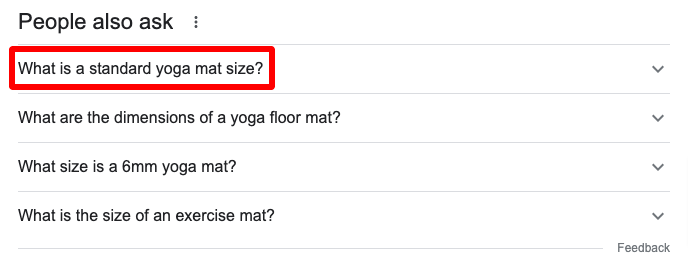
Structure your SEO landing page copy
Use the keywords you found in the previous step to build a rough structure for the title and subheadings of your SEO landing page.
Those titles and subheadings will form your heading tags. Also known as H tags and header tags, they’re a vital part of your on-page SEO, which has a big impact on how well your page will rank (more on that in the next section).
Heading tags run hierarchically from H1 – H6. Your landing page should have a single H1 tag and as many H2s, H3s, etc as you need to meet the search intent and outrank your competitors. The more in-depth, the better.
For instance, the heading tag structure of our yoga landing page might look like this:
Dimensions of a yoga mat: What size should you choose?
What is a standard yoga mat size?
- <H3> 5 best standard yoga mats
What is a large yoga mat size?
- <H3> 5 best yoga mats for tall people
👉 Do this: Structure your landing page, then write your page content. Your goal is to write better content (i.e. more in-depth) than the current #1 ranking page for your primary keyword — otherwise what’s the point?
Tackle other on-page SEO elements
We’ve covered a key part of on-page landing page SEO: heading tags.
But they’re only one of several on-page elements that help search engines understand what your page is about.
To give your page the best chance of strong rankings, you also need to nail all these elements:
Title tag
Your title tag is the first thing searchers see when they come across your landing page on a search engine results page (SERP):

It should be short — no more than 60 characters. And it should compel searchers to click.
👉 Do this: Try to place your primary keyword at the start of the page title and put less important words last.
Meta description
The meta description appears below the title tag in SERPs:

It’s kind of like an advertisement for your landing page, briefly explaining what it’s about and why people should click. Google highlights the search term — plus close matches and other relevant information — in bold text, helping the description stand out and improving click-through rate.
👉 Do this: Write a meta description of up to 160 characters for your landing page, including your primary keyword.
Visual elements
Adding images and videos to your landing page can persuade visitors to stick around for longer.
This shows Google that people like your content, which in turn can improve your rankings.
But that’s not the only benefit of using lots of visual elements.
Images can also show up in search results, giving you another source of traffic. Plus they’re often more efficient than text for communicating information about your product or service.
For instance, Gaiam uses images to help shoppers choose the right yoga mat:
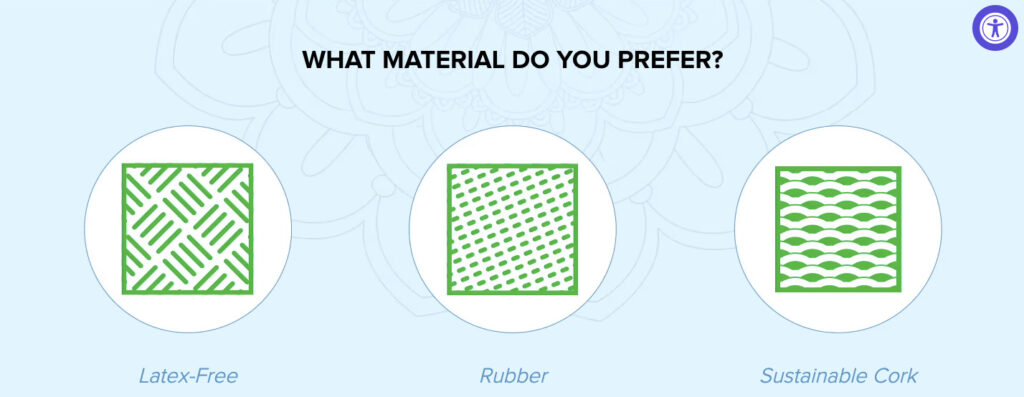
In fact, there’s barely any visible copy on this landing page, because it’s mostly contained within collapsible elements:
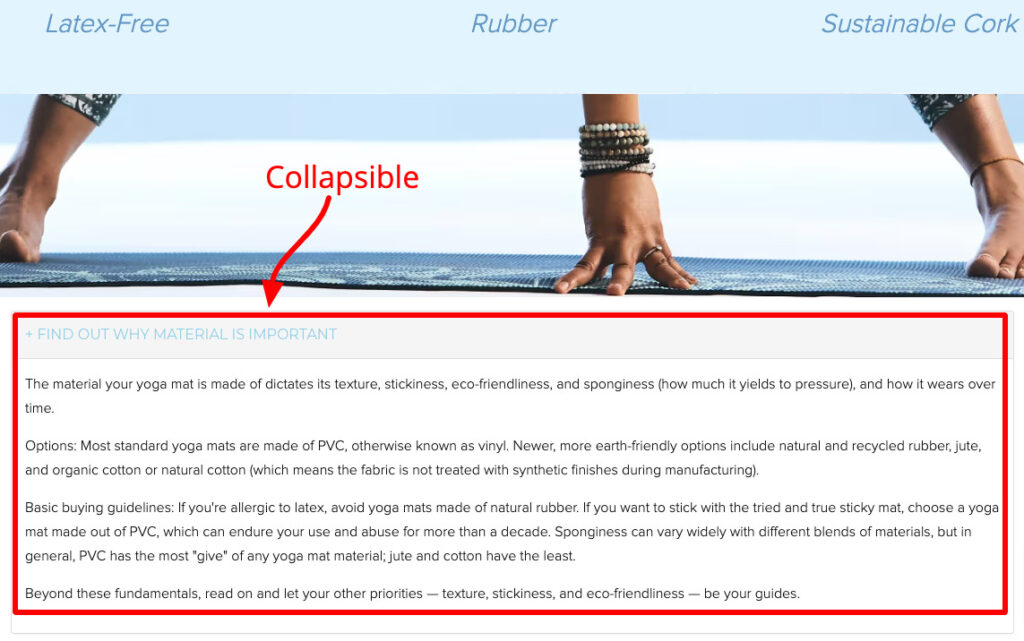
This makes the page quick and easy to scan.
There’s no “ideal ratio” of visual elements to text on a landing page. Rather than forcing yourself to include an arbitrary image or video every 100 words, focus on making the searcher’s life easier, adding as many as you need to fully answer their query.
👉 Do this: Find relevant imagery — and, ideally, a video too — to add to your landing page. If you don’t have any of your own assets, use galleries like Pixabay and Unsplash. Also, be sure to compress images and videos using tools like TinyPNG and Freeconvert to help your landing page load faster (more on this later).
Alt text
Even though images show up in search results, Google can’t actually see them.
You need to add descriptive alt text to your images to tell search engines what they’re about.
Alt text also improves the accessibility of your landing page by enabling screen readers to “describe” images to users with visual impairments.
When writing alt text, try to spell out what’s in the image and add keywords naturally.
For instance, the top image result for the term “dimensions of a yoga mat”…
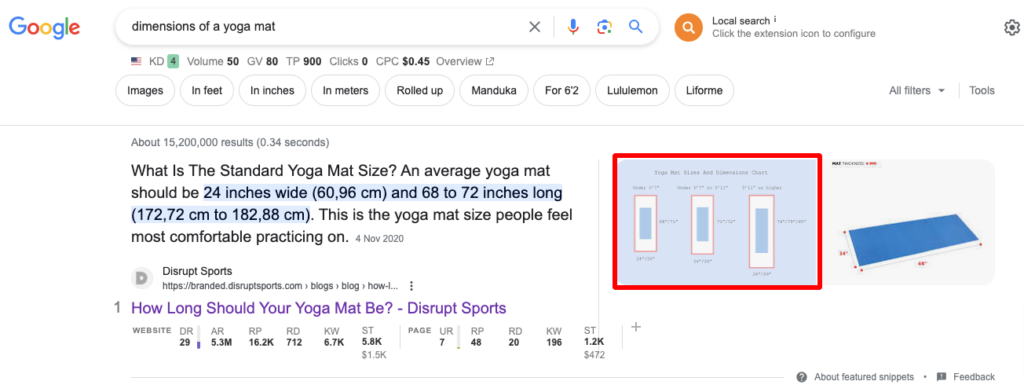
…has the alt text: “Illustration of yoga mat sizes.”
👉 Do this: Write up to 125 characters of alt text for each image on your landing page.
Landing page URL
The URL is one of the most easily overlooked elements of landing page SEO.
It helps search engines understand what your landing page is about and how it relates to other content on your site, so it should include your primary keyword.
👉 Do this: Write a URL for your landing page, including the primary keyword you’re targeting. Aim for a length of 50 – 60 characters. Read more about editing your URL with a domain, subdomain, and page path in our guide: How do I customize my landing page URL?
Page speed
Google has been using page speed as a factor in search rankings for well over a decade now.
Why? Because slow-loading pages create a poor user experience.
In fact, 45% of people have a negative impression of websites that take too long to load, and 32% say they’d likely never visit the site again.
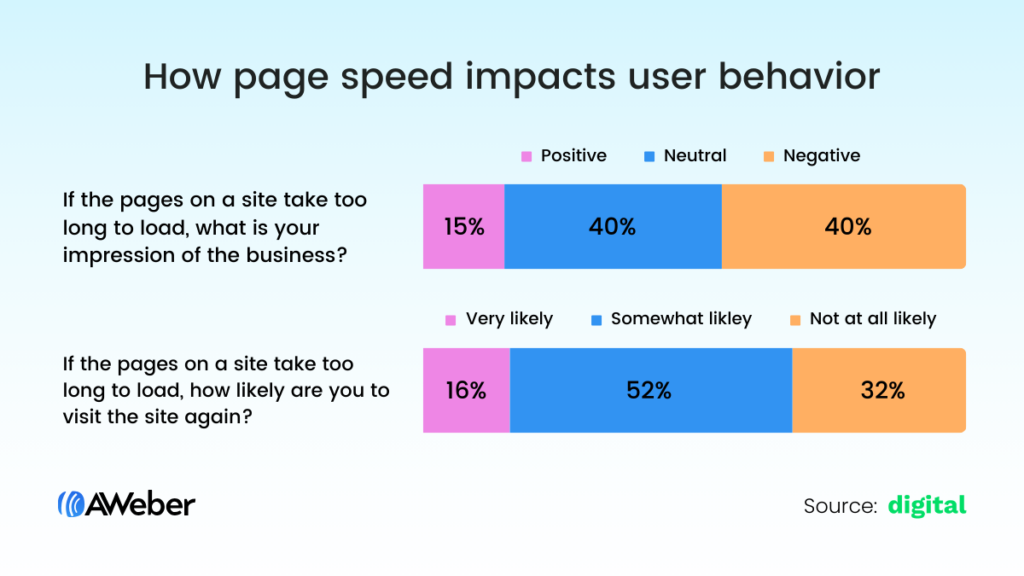
Google knows this, so it punishes slow-loading pages with lower rankings.
We’ve already discussed one key element of page speed optimization: compressing images and videos.
But there are lots of other factors, so you’ll want to go through them all to ensure a slick loading experience.
👉 Do this: Use Google’s free PageSpeed Insights tool to identify and correct issues slowing down your landing page.
Backlinks
Backlinks are links pointing to your landing page from external sites.
They’re a crucial element of landing page SEO, because when other websites link to your page, Google treats it as a kind of recommendation that you’ve produced high-quality content.
This has a massive impact on rankings.
In fact, on average, the #1 search result has 3.8X more backlinks than those in positions #2 – #10.
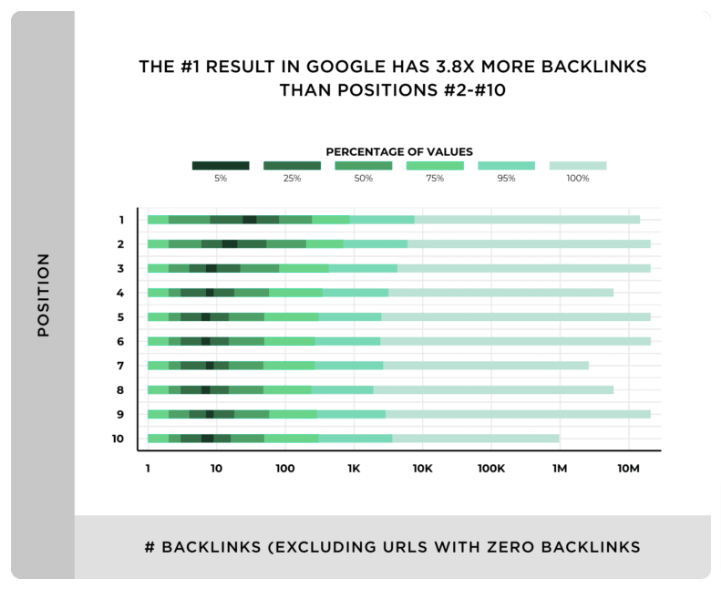
Some sites might link to your content without any effort on your part, especially if you’re a high-profile name in your niche and/or a trusted source of information.
For instance, Wikipedia has tens of millions of backlinks, and they likely didn’t have to ask for many of them.
But if you’re not Wikipedia, you’ll probably have to make a conscious effort to build those all-important backlinks yourself.
👉 Do this: There are various schools of thought on the best way to build backlinks. But one simple approach is to:
- Find the page that currently ranks #1 for your primary keyword
- Use an SEO tool like Ahrefs or Semrush to find sites that currently link to that page
- Ask those sites to link to you instead!
Level up your landing page SEO with AWeber
Before you can leverage any of these landing page SEO best practices, you first need to build your landing page.
AWeber can help.
Our landing page builder makes it quick and easy to build fast-loading, high-converting landing pages.
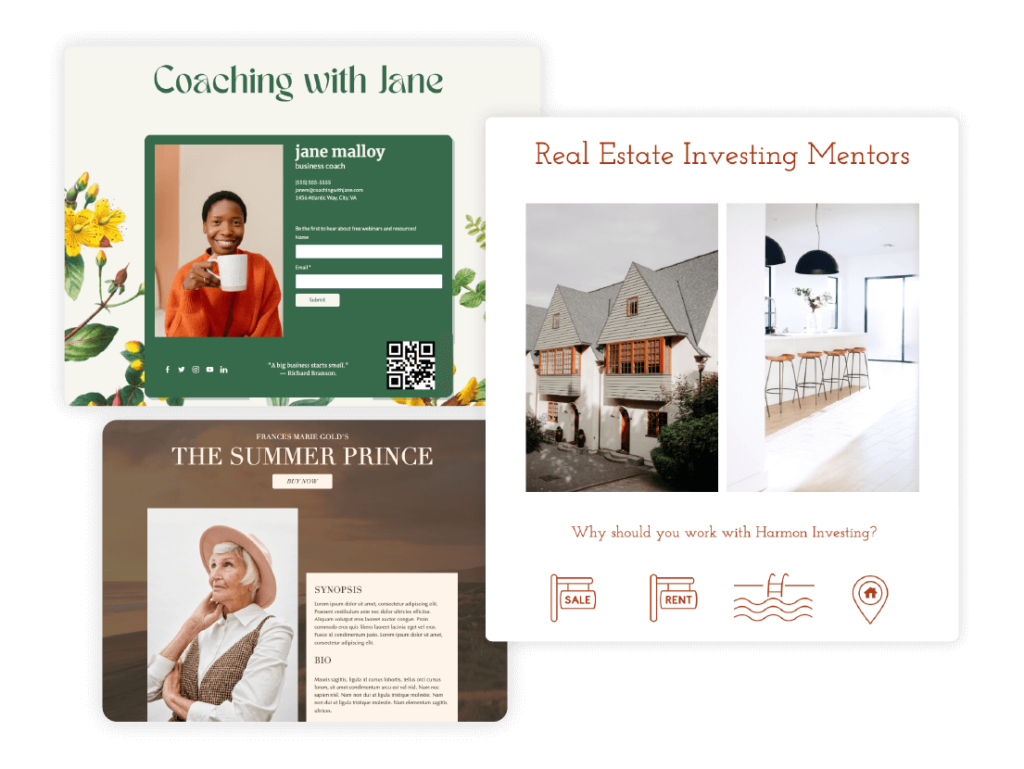
Built-in Canva access helps you bring your design ideas to life.
Or, if you need a little inspiration, start with one of our 100+ mobile-responsive pre-built templates and customize to your heart’s content using our simple drag-and-drop editor.
See for yourself by signing up for a free AWeber account.
Get started here!
 87% off ends soon!
87% off ends soon! 
